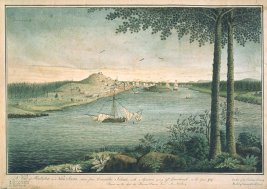The NSR was taken over by the Government of Canada in 1867 as one of the terms of Confederation. In 1877, a new federal Crown corporation, the Intercolonial Railway (ICR), opened a magnificent new terminal railway station at the foot of North Street, south of Richmond and much closer to the city's downtown. This impressive Second Empire structure was designed by David Stirling, who also designed the Provincial Building and St. David's Presbyterian Church on Grafton Street. The station was faced by the King Edward Hotel, located immediately west of the station, which stood roughly beneath the present-day Angus L. Macdonald Bridge where it crosses Barrington Street opposite the main gate to HMC Dockyard. The North Street Station and the waterfront terminal trackage leading to it were badly damaged in the Halifax Explosion on 6 December 1917. Passenger trains were temporarily diverted to the unfinished south end terminal tracks for two days. However the North Street Station was quickly repaired to enable it to operate another 2 years before closing in 1920.
South End terminal project[edit]
The ICR's owner the Government of Canada, announced at a Halifax Board of Trade luncheon on 30 October 1912 that plans were being drafted for a major railway and shipping terminal at Greenbank, near Point Pleasant Park in the city's South End.
A route for the railway was chosen along the western side of the Halifax Peninsula bordering the Northwest Arm by F.W. Cowie, a government engineer. This project required a deep cut extending up to 100 feet deep through solid Halifax slate for 8 kilometres (5.0 mi) to connect with the main line at Fairview. 16 arched concrete road bridges were to span this trench to maintain connections for the street network.
The official start of construction is dated 31 July 1913 and equipment was moved into Halifax by the fall. Crews proceeded from the north, with trains hauling the rock to the southwestern corner of Bedford Basin where it was dumped in front of Mt. St. Vincent College to create the ICR's new classification yard. Crews working from the south hauled the rock to dump into Halifax Harbour, creating new deepwater shipping piers and dockside warehouses that were called the Halifax Ocean Terminal. The crews met in the fall of 1917 but several years of work remained before the trackage and docks would be operational.
A trans-Atlantic ocean liner passenger terminal was planned for the Ocean Terminal piers (later Pier 21) and the ICR had plans to build a larger railway station and adjoining hotel, however Canada was deeply committed to the First World War and the North Street Station continued to be the only railway station serving the city.[1]
The "Temporary" Station 1920 to 1928[edit]
Meanwhile, the ICR was merged into a new federal Crown corporation, the Canadian National Railways (CNR) in 1918. The CNR opted to locate a temporary new passenger station in the Halifax Ocean Terminal project at the south end of the city that fall and on 22 December 1918, the Maritime Express departed for the first time from the new (temporary) south end station.[2] The station was a long, single-story brick structure. Although considered "temporary", it operated for ten years.
New South End station 1928 to present[edit]
The newly-built station alongside the Hotel Nova Scotian in 1931.By the mid-1920s, CNR and the federal government were able to agree on building a new Union station passenger terminal near the Halifax Ocean Terminals which included the new ocean liner passenger terminal at Pier 21. The union station would serve not only CN but also the Canadian Pacific Railway's Nova Scotia subsidiary, Dominion Atlantic Railway which operated passenger trains from Yarmouth, Digby and the Annapolis Valley into Halifax using trackage rights over CNR from Windsor Junction to the Halifax Ocean Terminal.
The new, and present, station opened in 1928 at the south end of Hollis Street, opposite Cornwallis Park. The structure is constructed of white limestone and has a colonnaded entry off Hollis Street. Inside, the Ticket Lobby has a high arched ceiling with a seated waiting area and ticketing/baggage counters. At the time of its construction, the station had a massive covered train shed which extended for 1, 500 feet south over the station tracks to protect passengers boarding and disembarking from the weather. The earlier 1920 "temporary" station was converted to an attached baggage and express shed. CNR also had a coach yard with repair/service shop facilities for its passenger train equipment immediately southwest of the station's trainshed. Finally, a turn-table was located immediately southeast of the trainshed to permit locomotives and cars to be turned around, since the station was a stub-end terminal.
Displayed beside the new station was the 1839 locomotive Samson, the oldest in Canada. It remained on display until 1950 when it was moved to Stellarton, Nova Scotia.
Ocean Terminals in 1934 the RMS Majestic docked at Pier 21. Halifax Station is on the far right beside the Hotel Nova Scotian and Samson is at lower centre.An adjoining CNR Hotel, the Hotel Nova Scotian, was also built as part of the same project, although it opened 2 years later on 23 June 1930 and has a markedly different, yet complementary, architecture style.
The new station and the adjoining Hotel Nova Scotian were connected to the nearby Pier 21 ocean liner passenger terminal by an overhead walkway that crossed the numerous sidings feedin the ocean terminal sheds. Frequently, CNR passenger trains connecting to ships would operate to the Halifax Ocean Terminal, then back into the Halifax Railway Station afterward, or vice versa. A booking office for immigrants and platforms at Ocean Terminal served as an auxiliary station for special colonist car trains when large numbers of immigrants arrived.
The station saw intensive traffic during World War Two, moving military personnel to East Coast bases and overseas. Station use declined in the postwar period as part of the broad loss of rail passenger traffic. Locals runs, which also served as suburban trains for Halifax, were the first to be discontinued. CN cut one of its three daily Halifax-Montreal trains, the Maritime Express during the early 1970s, leaving only the and the, along with various local services to New Brunswick and Sydney provided by Dayliners. The Dominion Atlantic Railway also gradually reduced departures to a single daily voyage in each direction from the Halifax Railway Station to Yarmouth via Kentville and Digby.








